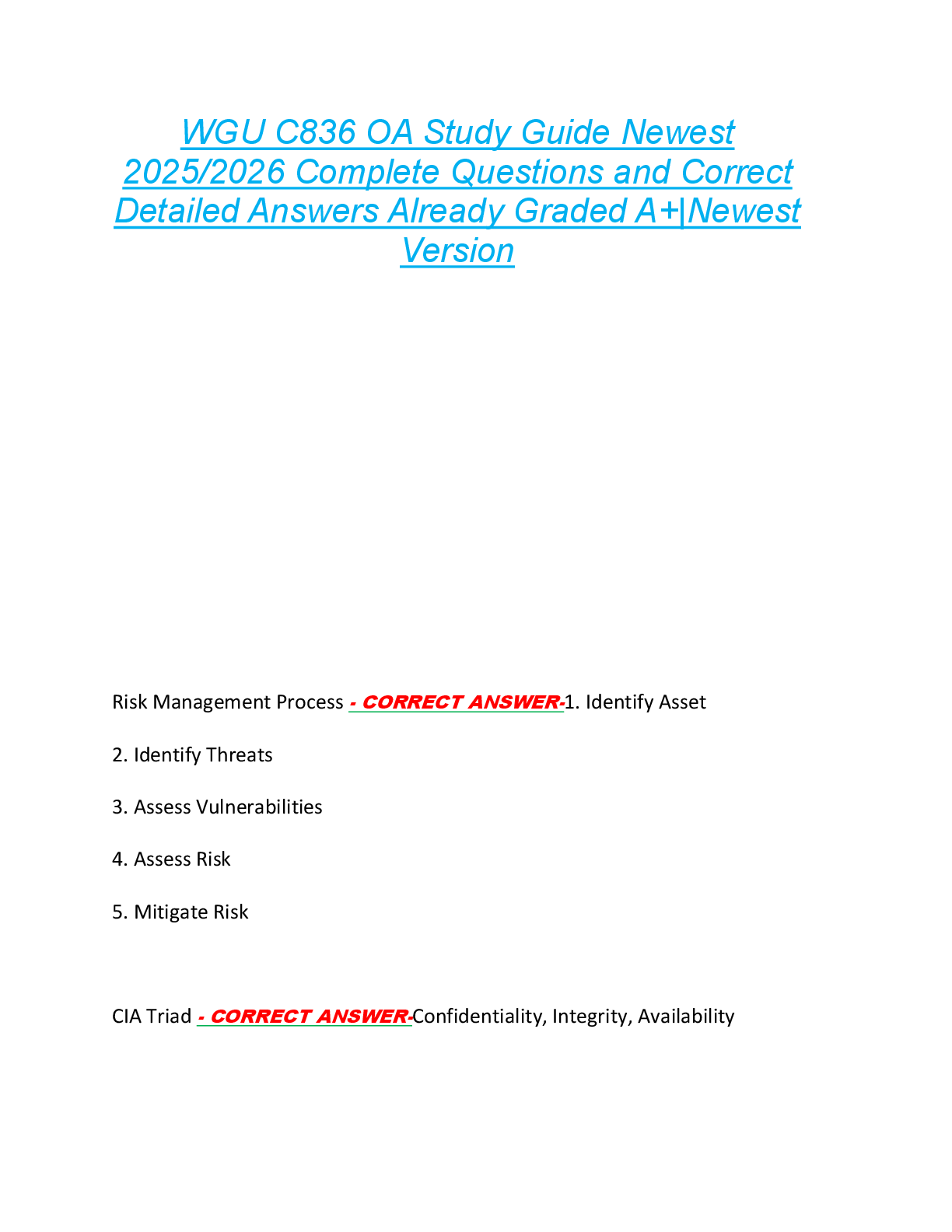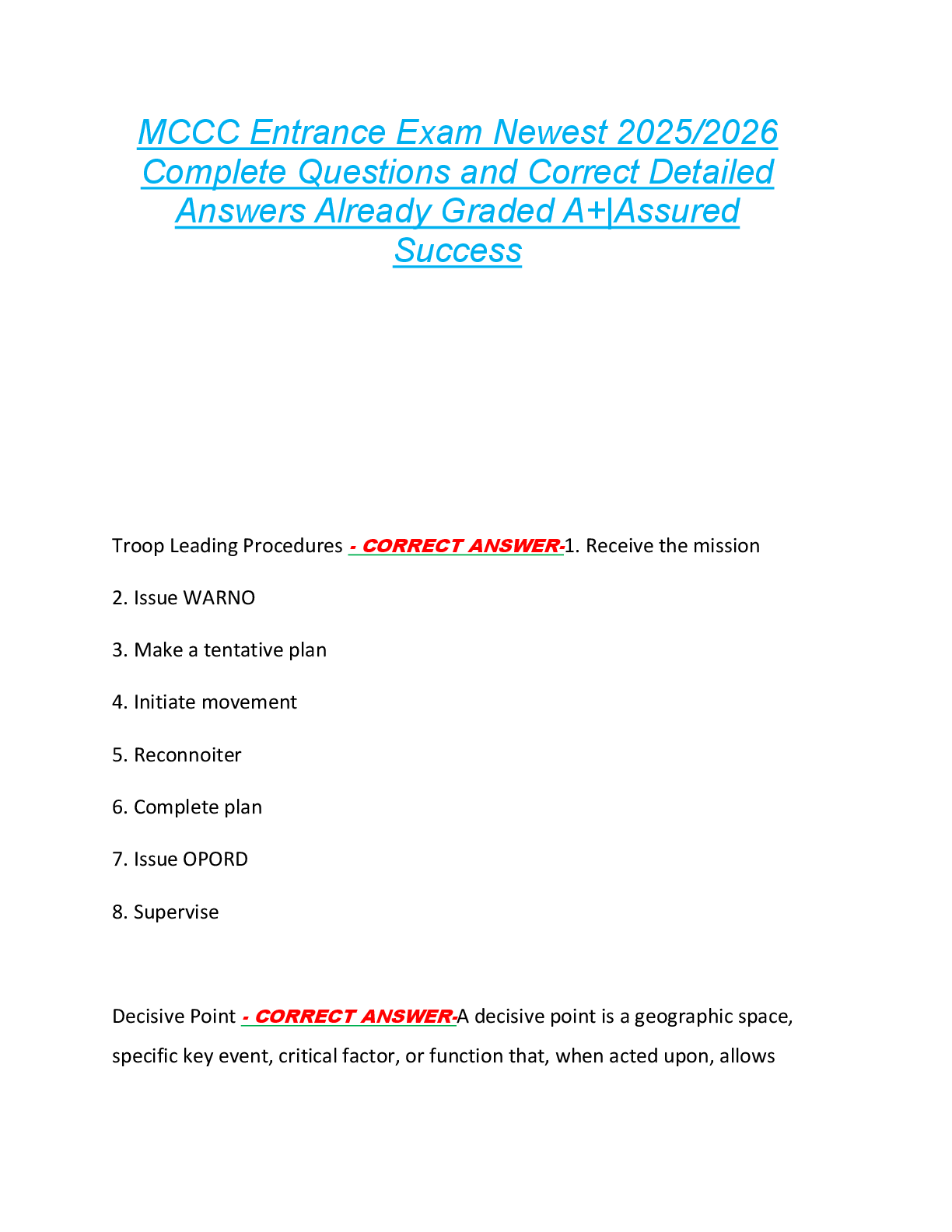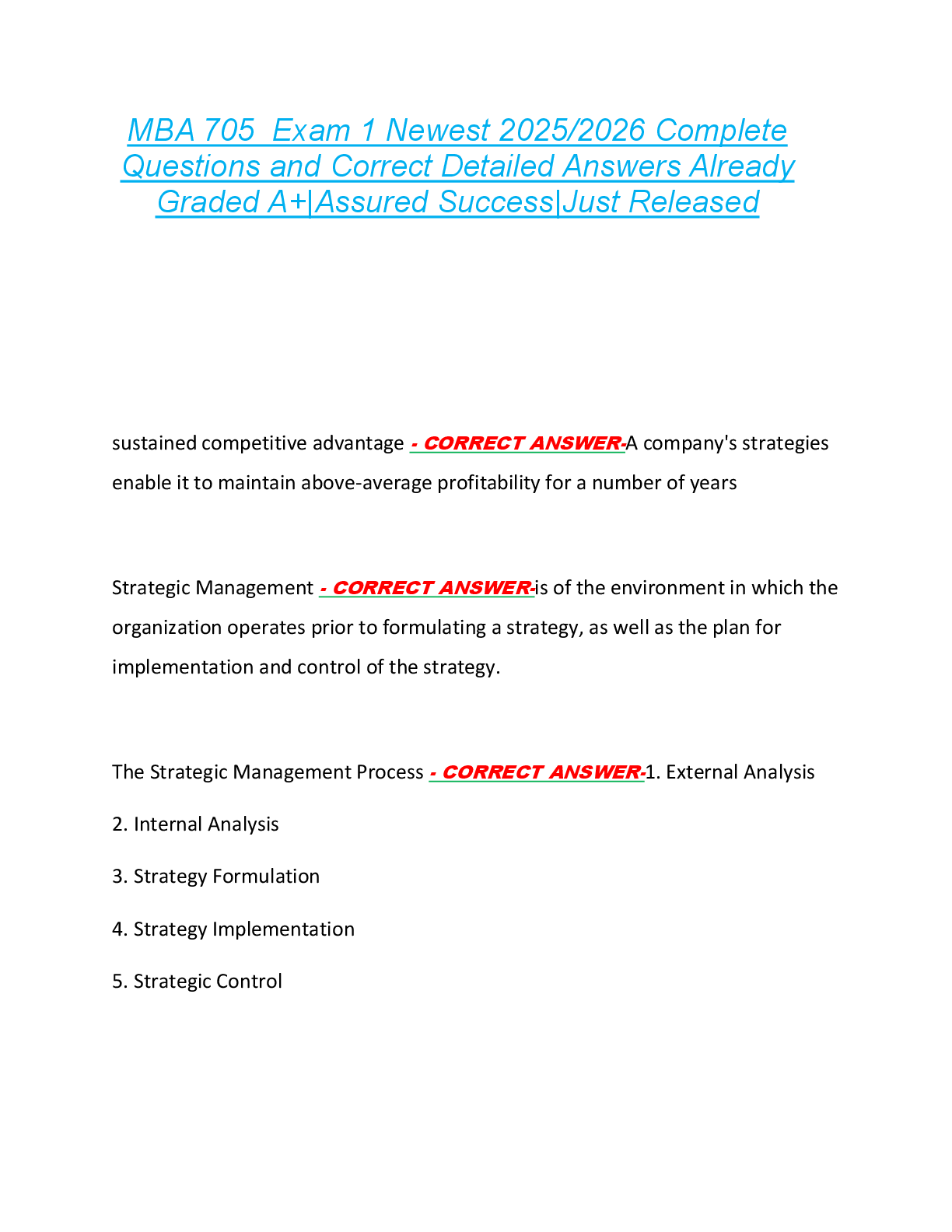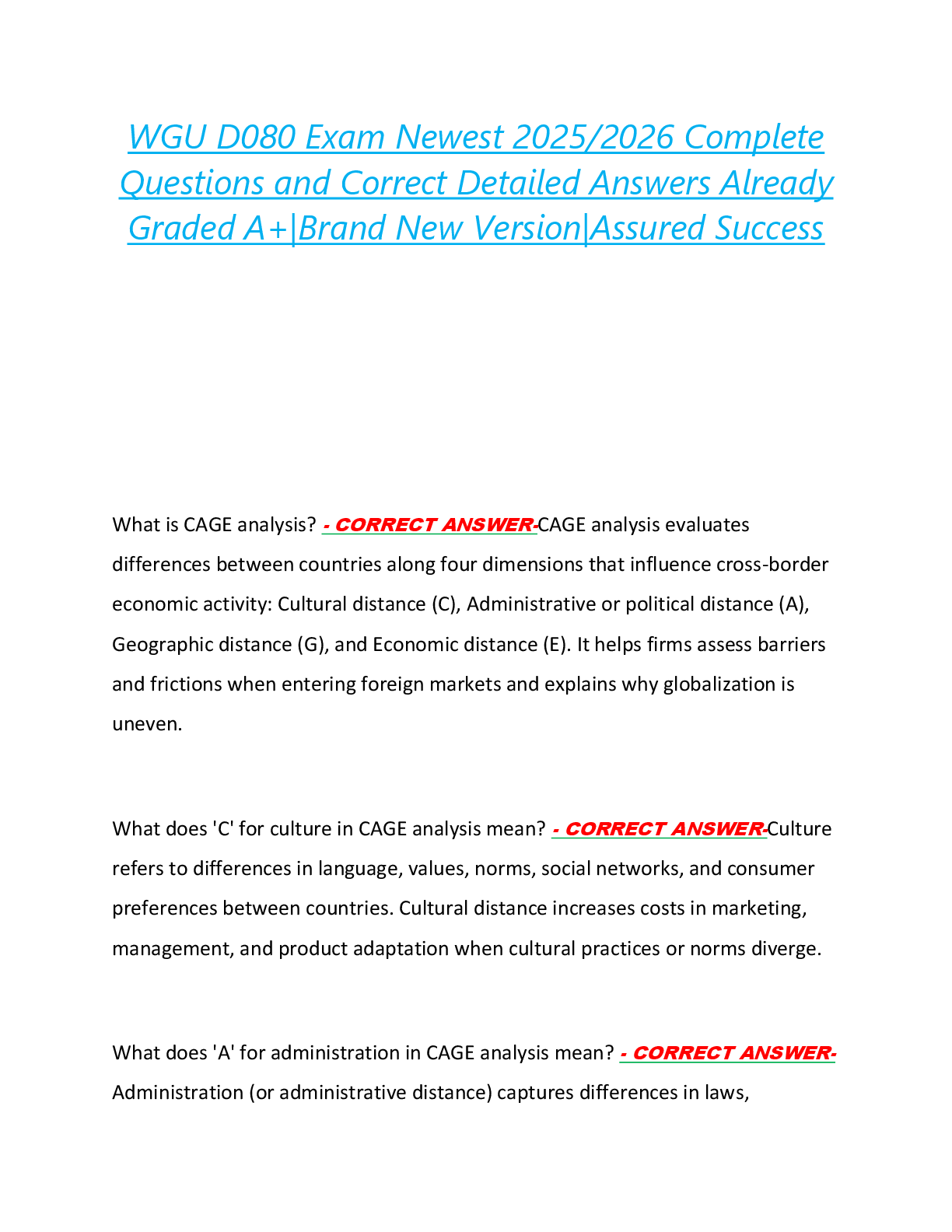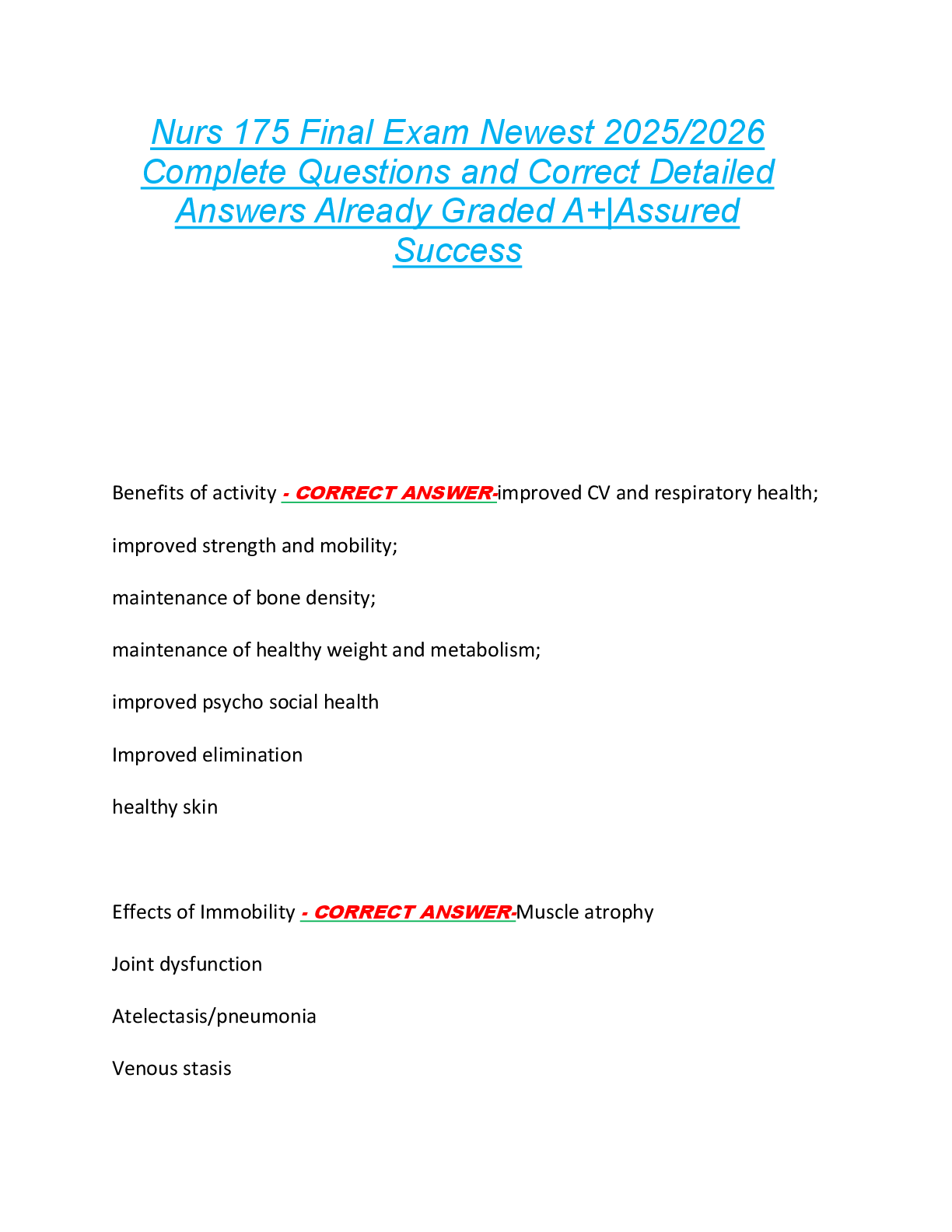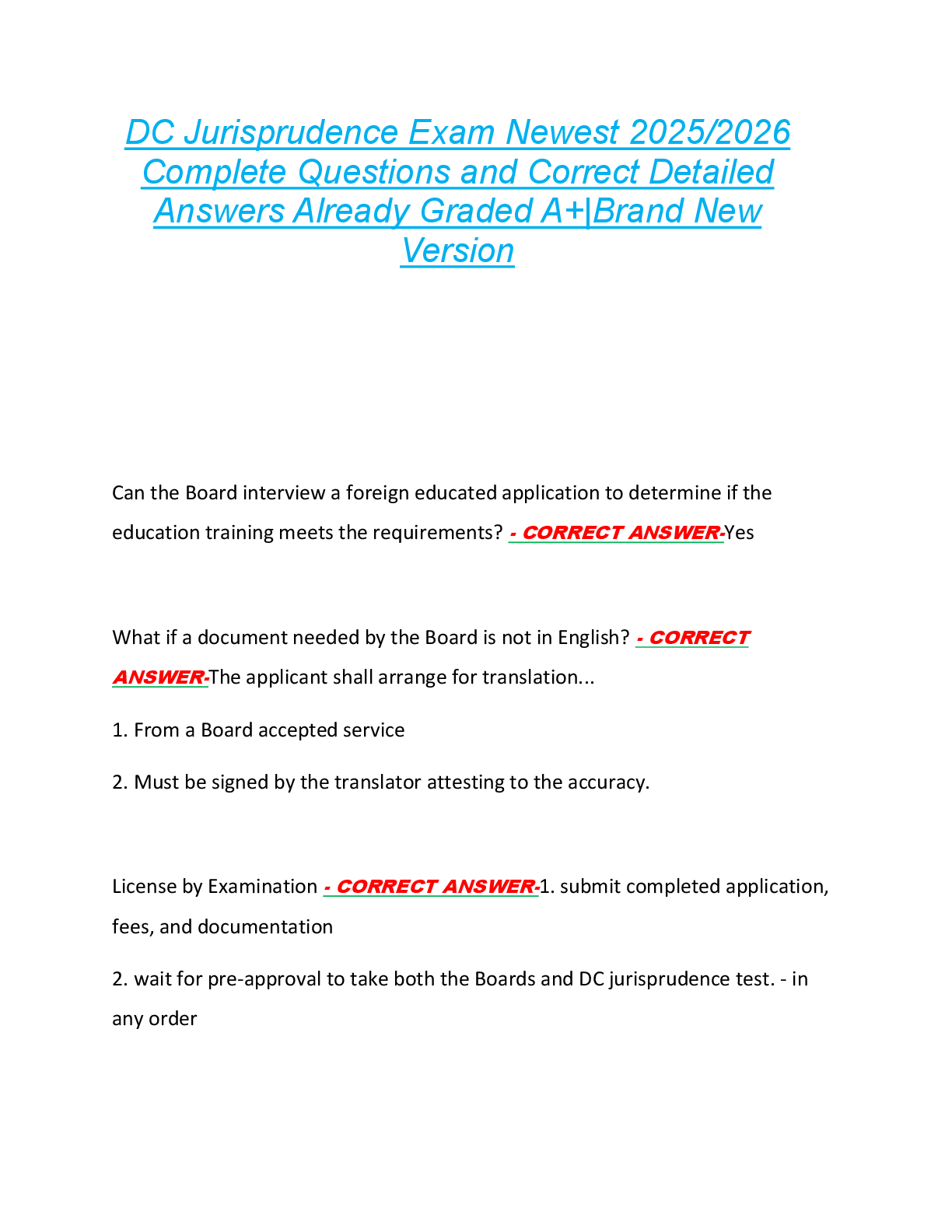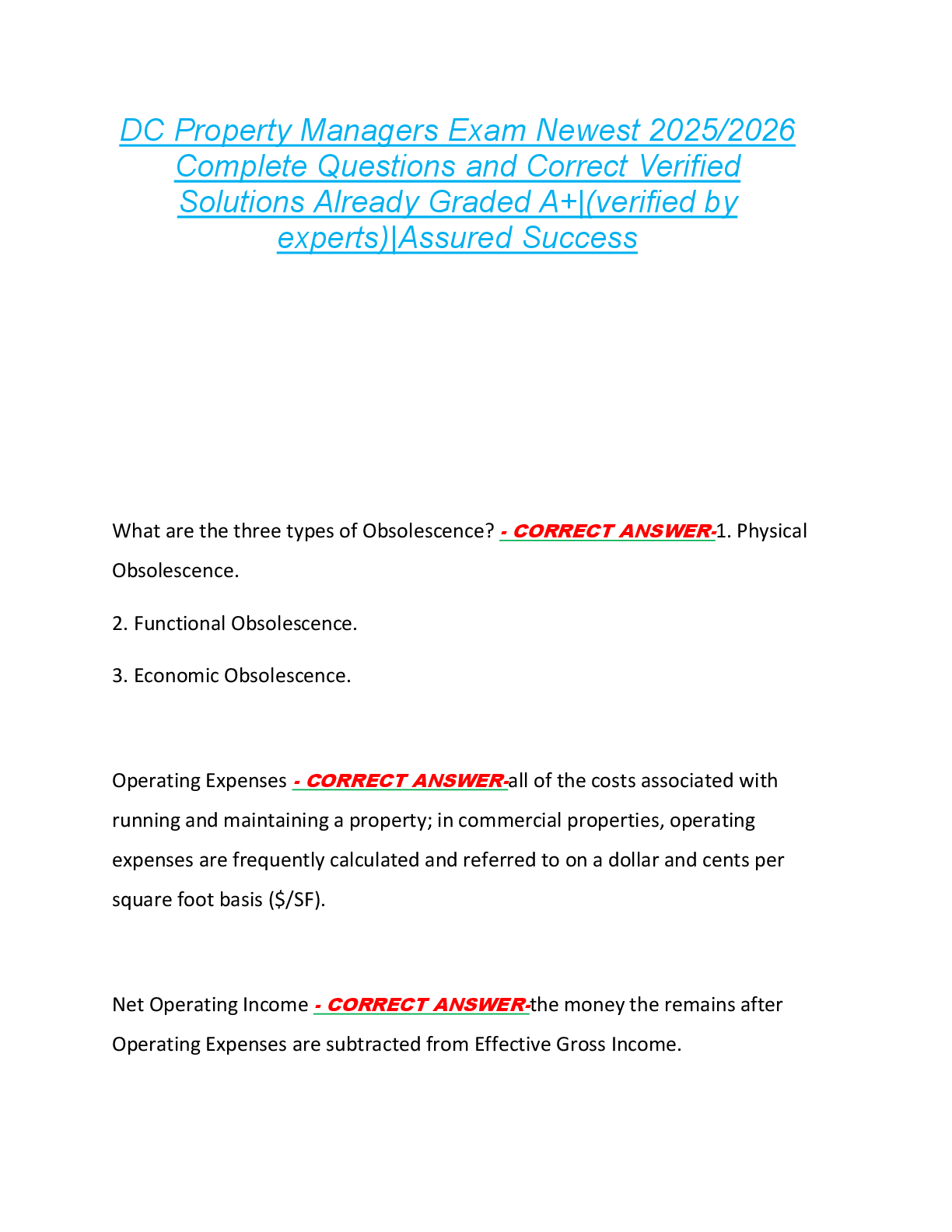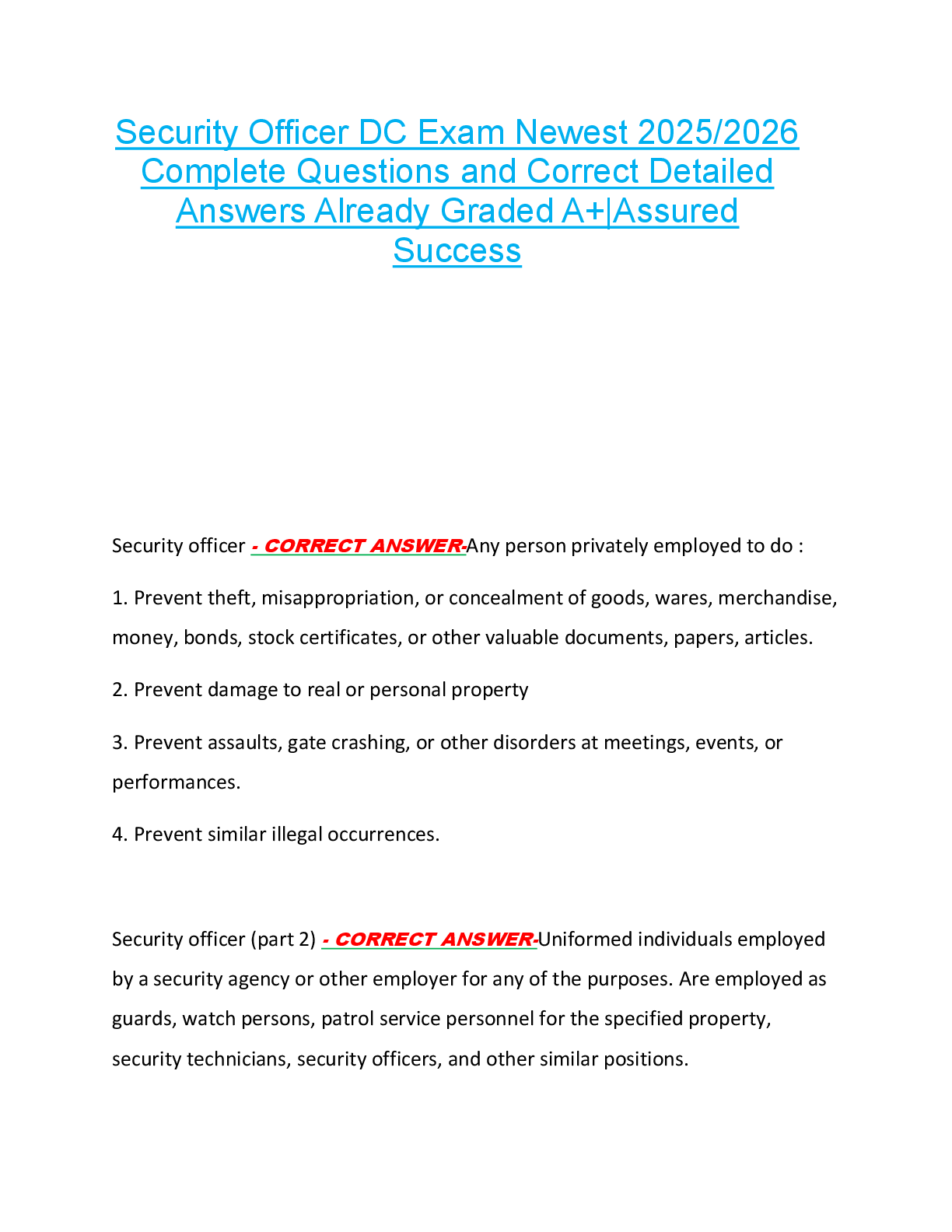PSY 7712 Unit 8 Quiz Questions and Answers- Capella University | 100% Guaranteed Pass
Document Content and Description Below
Review Test Submission: [u08q1] Unit 8 Quiz 1
Attempt Score 100 out of 100 points
Time Elapsed 1271 hours, 36 minutes
Results Displayed All Answers, Submitted Answers, Feedback, Incorr
...
ectly Answered Questions
Question 1
3 out of 3 points
A assessment is a direct, data-based method of presenting one stimulus
contingent upon a response and measuring the extent to which that response increases over time. This type of assessment verifies whether or not a stimulus functions as a
reinforcer. A assessment measures preference for stimuli, but does not verify
whether these stimuli are actually reinforcers or not.
Selected Answer:
b.
Reinforcer, preference.
Answers:
a.
Preference, reinforcer.
b.
Reinforcer, preference.
c.
Stimulus, preference.
d.
Reinforcer, functional.
Answer Feedback: Correct.
4 out of 4 points
An S-delta is:
Selected Answer:
a.
A stimulus, in the presence of which reinforcement is withheld if a target response occurs.
Answers:
a.
A stimulus, in the presence of which reinforcement is withheld if a target response occurs.
b.
A stimulus, in the presence of which reinforcement is delivered if a target response occurs.
c.
The same thing as a discriminative stimulus.
d.
A consequence event.
Answer Feedback:
Correct.
4 out of 4 points
An advantage to survey methods of evaluating preference is that they are relatively uncomplicated to conduct. A disadvantage of such methods is that:
Selected Answer:
a.
They may not yield any more accurate information than chance.
Answers:
a.
They may not yield any more accurate information than chance.
b.
They can trigger disruptive behavior.
c.
They are relatively time consuming to conduct.
d.
It is impossible to conduct them with learners who have limited language skills.
Answer Feedback:
Correct.
3 out of 3 points
An intern described a new client to his university class. He noted that the client showed problems with sustaining attention during classroom instruction and showed tendencies of ADHD. Later, in his description, he surmised that the client's ADHD was a cause for his inattentiveness. In this discussion, the two identified variables (ADHD and inattentiveness) are effects and unable to be separated from one another so that one could be manipulated, to test the effect on the other. This is an example of:
Selected Answer:
a.
Circular reasoning.
Answers:
a.
Circular reasoning.
b.
Victim blaming.
c.
Constructive feedback.
d.
All of the above
Answer Feedback: Correct.
4 out of 4 points
Assume you give a student in your class a forced choice preference assessment. On this preference assessment, computer time was ranked highest (that is, it was selected the most frequently). What can you say about computer time, based on this information?
Selected Answer:
b.
Computer time may be a reinforcer for this student.
Answers:
a.
Computer time is a reinforcer for this student.
b.
Computer time may be a reinforcer for this student.
c.
Computer time is a punisher for this student.
d.
Computer time is a non-preferred stimulus.
Answer Feedback: Correct.
4 out of 4 points
another student takes his toys away from him. When Ben hits them, the other children tend to return the toys they took away from him. What can be said about this situation?
Selected Answer:
a.
Ben's aggression has been positively reinforced by the children returning the toys to him.
Answers:
a.
Ben's aggression has been positively reinforced by the children returning the toys to him.
b.
Ben's aggression has been negatively reinforced by the children taking the toys away from him.
c.
Ben's aggression has been punished (via presentation) by the children returning the toys to him.
d.
There is not enough information to answer this question.
Answer Feedback:
Correct.
4 out of 4 points
Elsa conducted a preference assessment for Jordan, a five-year-old boy with autism with whom she works. She arranged 10 stimuli on a table and allowed him a little time to interact with the stimuli prior to the assessment. Then, she began her assessment, allowing Jordan to select a stimulus and play with it. When Jordan finished playing with that item, Elsa put the toy away and allowed Jordan to select another toy. She repeated this procedure until there were only three toys left. What form of preference assessment is this?
Selected Answer:
c.
Multiple stimulus.
Answers:
a.
Forced choice.
b. Survey.
c.
Multiple stimulus.
d.
Single stimulus.
Answer Feedback: Correct.
4 out of 4 points
Here is a common situation: New parents put a child to bed. The child begins to cry, so the parents comfort the child and allow the child to sleep in bed with them. Thus, when they put the child to bed in the future, she is more likely to cry. What has occurred in this situation?
Selected Answer:
a.
The parents have positively reinforced crying.
Answers:
a.
The parents have positively reinforced crying.
b.
The parents have negatively reinforced crying.
c.
The parents have punished crying by presenting a stimulus.
d.
There is not enough information to answer this question.
Answer Feedback: Correct.
4 out of 4 points
Here is a common situation: New parents put a child to bed. The parents are very tired, because they work hard and are trying to raise a young child. The child begins to cry.
When they put the child in their own bed, the child stops crying. Therefore, in the future, they are more likely to put the child in their own bed. What has occurred in this situation?
Selected Answer:
b.
The parents have been reinforced for putting the child in their bed via negative reinforcement.
Answers:
a.
The parents have been reinforced for putting the child in their bed via positive reinforcement.
b.
The parents have been reinforced for putting the child in their bed via negative reinforcement.
c.
The parents have been punished for putting the child in their bed via punishment by removal.
d.
There is not enough information to answer this question.
Answer Feedback:
Correct.
4 out of 4 points
If one compares the effects of response dependent delivery of a stimulus to a response independent schedule delivery of a stimulus to analyze whether or not the stimulus serves as a reinforcer, which assessment method is one using?
Selected Answer:
b.
Multiple schedule assessment.
Answers:
a.
Concurrent schedule assessment.
b.
Multiple schedule assessment.
c.
Progressive-ratio schedule assessment.
d.
Paired stimulus assessment.
4 out of 4 points
If one wants to determine the effectiveness of a stimulus as a reinforcer as the requirements to earn that reinforcer change over time, which assessment method would be most appropriate?
Selected Answer:
c.
Progressive-ratio schedule assessment.
Answers:
a.
Concurrent schedule assessment.
b.
Multiple schedule assessment.
c.
Progressive-ratio schedule assessment.
d.
Paired stimulus assessment.
4 out of 4 points
If one wants to determine the effectiveness of a stimulus as a reinforcer relative to another stimulus, which assessment method would be most appropriate?
Selected Answer:
d.
Paired stimulus assessment.
Answers:
a.
Concurrent schedule assessment.
b.
Multiple schedule assessment.
c.
Progressive-ratio schedule assessment.
d.
Paired stimulus assessment.
Answer Feedback: Correct.
Question 13
3 out of 3 points
In a concurrent schedules of reinforcement assessment:
Selected Answer:
a.
Two schedules of reinforcement are in place at the same time. An individual's response allocation among two different responses (each associated with a different schedule) is measured.
a.
Answers:
Two schedules of reinforcement are in place at the same time. An individual's response allocation among two different responses (each associated with a different schedule) is measured.
b.
Two different reinforcement schedules are in place at different times, and each as its own discriminative stimulus. Typically, one schedule is response dependent and the other is response independent, and responding under each schedule is measured.
c.
The requirements for earning reinforcement are systematically increased over time. The behavior analyst measures the point at which responding declines.
d.
All the above.
Answer Feedback:
Correct.
4 out of 4 points
Ms. Franklin conducted a survey with her class to identify stimuli that might serve as reinforcers. All the students in her class indicated that extra recess time and pencils would be some things they would like to earn. She then collected baseline data on the number of math problems each student correctly completes during seatwork time.
Following this, she told her students they can have five minutes of extra recess if they complete five more math problems during seatwork time today than they did yesterday. Each day, she increased the number of math problems the students needed to complete to earn extra recess. She kept a graph of the results, which showed a steadily increasing trend since baseline. What can be said about what she has done?
Selected Answer:
c.
She has demonstrated that extra recess functions as a reinforcer for work completion.
Answers:
a.
She has demonstrated that extra recess functions as a punisher for work completion.
b.
She has demonstrated that pencils have no effect on work completion.
c.
She has demonstrated that extra recess functions as a reinforcer for work completion.
d.
She has demonstrated that pencils are a reinforcer for work completion.
Answer Feedback:
Correct.
4 out of 4 points
National Public Radio (NPR) often holds fund drives to raise money for their radio stations. They frequently offer prizes for people who donate a certain amount of money. For example, they might offer a CD for those who donate at least $50 to the station. It is not clear whether this actually increases donations. What can we say about this situation?
Selected Answer:
c.
The CDs function as a reward for donating money.
Answers:
a.
The CDs function as a reinforcer for donating money.
b.
The money functions as a reinforcer for getting a CD.
c.
The CDs function as a reward for donating money.
d.
The money functions as a reward for getting a CD.
Answer Feedback: Correct.
3 out of 3 points
Negative reinforcement involves:
Selected Answer:
b.
Removing an aversive stimulus contingent upon a behavior.
Answers: a.
Presenting an aversive stimulus contingent upon a behavior.
b.
Removing an aversive stimulus contingent upon a behavior.
c.
Removing a desirable stimulus contingent upon a behavior.
d.
Punishing a behavior.
Answer Feedback: Correct.
4 out of 4 points
One advantage to free operant preference assessments is:
Selected Answer:
d.
All of these are advantages to the free operant preference assessment.
Answers: a.
There is less potential for children to satiate on the stimuli than with
forced choice and approach responding assessments.
b.
These can be less time consuming than forced choice and approach responding assessments.
c.
They provide a rank order of preferences, unlike forced choice assessments.
d.
All of these are advantages to the free operant preference assessment.
Answer Feedback:
Correct.
3 out of 3 points
Positive and negative reinforcement are similar in that:
Selected Answer:
d.
All of the other answers are correct.
Answers:
a.
They both produce an increase in responding.
b.
They both involve a stimulus change following a target behavior.
c.
They can either be conditioned or unconditioned.
d.
All of the other answers are correct.
Answer Feedback: Correct.
4 out of 4 points
The Premack principle is useful for:
Selected Answer:
c.
Increasing low probability behaviors.
Answers: a.
Increasing high probability behaviors.
b.
Decreasing high probability behaviors.
c.
Increasing low probability behaviors.
d.
Decreasing low probability behaviors.
Answer Feedback: Correct.
3 out of 3 points
The key distinction between positive and negative reinforcement is:
Selected Answer:
c.
The type of stimulus change that occurs following a response.
Answers:
a.
The effect on behavior.
b.
The stimulus change with positive reinforcement has a discrete onset and offset, where the stimulus change with negative reinforcement does not.
c.
The type of stimulus change that occurs following a response.
d.
Both A and B.
Answer Feedback:
Correct.
4 out of 4 points
Unconditioned reinforcers are:
Selected Answer:
d.
Stimuli, such as food and water, that are inherently reinforcing for individuals.
Answers: a.
Stimuli, such as praise, that individuals have learned to like through
pairing with other unconditioned reinforcers.
b.
Stimuli, such as rock music, that were once punishing (aversive) but are now things the individual likes.
c.
Stimuli, such as meat powder, that cause reflex actions to occur.
d.
Stimuli, such as food and water, that are inherently reinforcing for individuals.
Answer Feedback:
Correct.
4 out of 4 points
What is the advantage of using generalized conditioned reinforcers?
Selected Answer:
a.
They are less susceptible to satiation, because they can be exchanged for a wide variety of other reinforcers.
Answers:
a.
They are less susceptible to satiation, because they can be exchanged for a wide variety of other reinforcers.
b.
They are easier for children to obtain than other forms of reinforcement.
c.
They are negative reinforcers, which are more powerful than positive reinforcers.
d.
None of these are advantages of generalized reinforcers.
Answer Feedback:
Correct.
3 out of 3 points
Which is the correct representation of the sequence of the four terms of a contingency of reinforcement?
Selected a.
Answer:
EO, SD, target response, Sr+ (future responding increases; the EO is relevant to the Sr+ selected).
Answers:
a.
EO, SD, target response, Sr+ (future responding increases; the EO is relevant to the Sr+ selected).
b.
SD, EO, target response, Sr+ (future responding may increase; the EO is relevant to the Sr+ selected).
c.
SD, EO, target response, Sr+ (future responding decreases; the EO is relevant to the Sr+ selected).
d.
EO, SD, target response, Sr+ (future responding increases; the EO is not relevant to the Sr+ selected).
Answer Feedback:
Correct.
4 out of 4 points
Which is true?
Selected Answer:
b.
The behavior that occurs temporally closest to the presentation of a reinforcer will be strengthened by its presentation.
a.
Answers:
When implementing a reinforcement contingency, it is acceptable to wait 30 seconds following the emission of a target response to deliver the reinforcer.
b.
The behavior that occurs temporally closest to the presentation of a reinforcer will be strengthened by its presentation.
c.
Establishing operations are relatively consistent and do not tend to change over time.
d.
For reinforcement to work, the individual must be aware that reinforcement has occurred.
Answer Feedback:
Correct.
3 out of 3 points
Which is true?
Selected Answer:
a.
Another descriptor for the three-term contingency is the discriminated operant.
Answers:
a.
Another descriptor for the three-term contingency is the discriminated operant.
b.
A primary reinforcer is a conditioned reinforcer.
c.
As a general rule, it is safer to assume that a high preference item identified through a trial-based method of assessment is less likely to serve as a reinforcer than one identified via a survey method of assessment.
d.
All of the other answers are correct.
Answer Feedback:
Correct.
4 out of 4 points
Which of the following is, or are, conditioned reinforcers?
Selected Answer:
b.
Money and tokens.
Answers:
a. Food.
b.
Money and tokens.
c. Sleep.
d.
All of the above are conditioned reinforcers.
Answer Feedback: Correct.
4 out of 4 points
Which of the following represents an example of the Premack principle?
Selected Answer:
c.
Telling a child to eat his vegetables, then he can have dessert.
Answers:
a.
Telling a child to eat his vegetables or he must go to time out.
b.
Explaining to a child why it is a good thing to eat vegetables.
c.
Telling a child to eat his vegetables, then he can have dessert.
d.
Allowing a child to have dessert first, if he promises to eat his vegetables later.
Answer Feedback:
Correct.
[Show More]
Last updated: 3 years ago
Preview 1 out of 29 pages


.png)


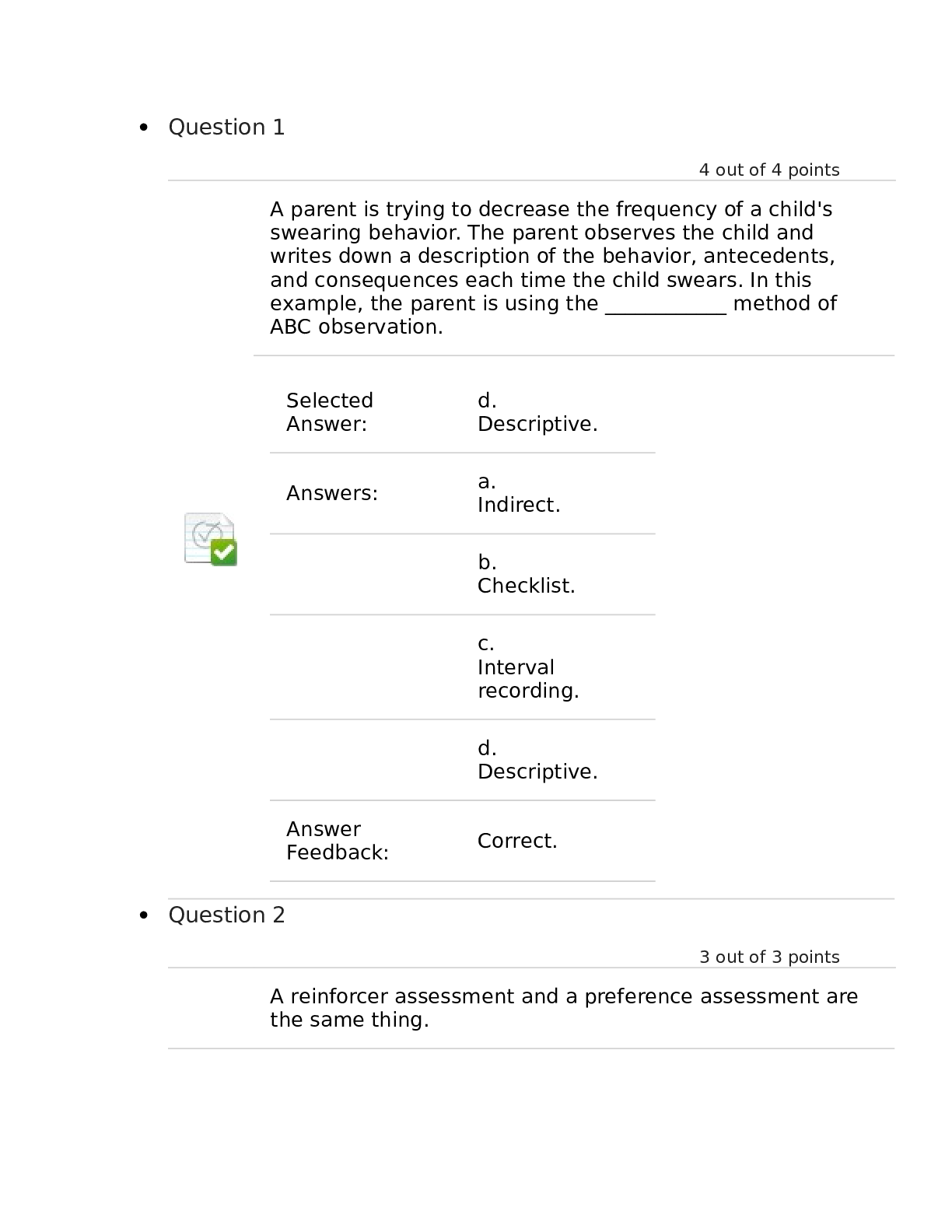


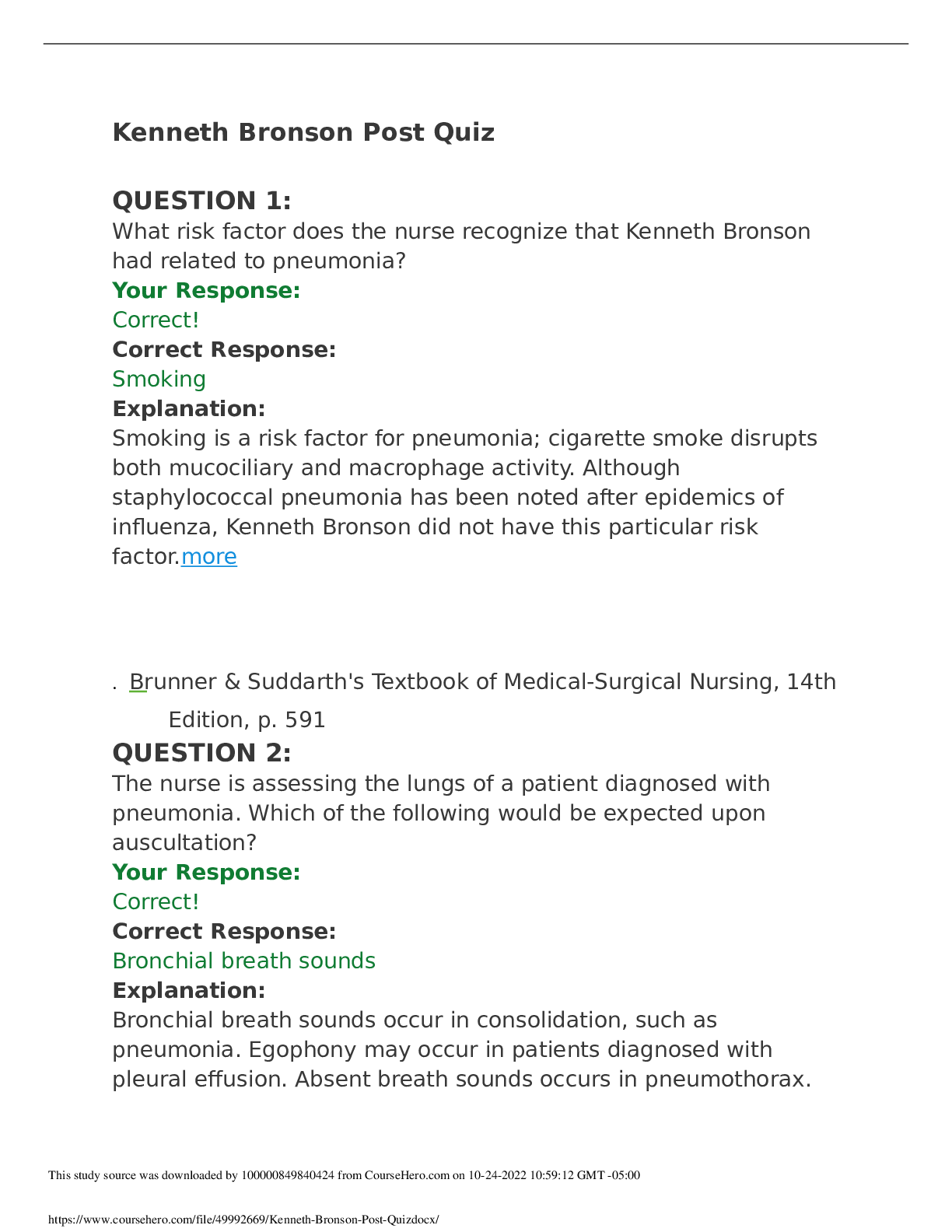



 Questions and Answers 100% VERIFIED.png)
 Questions and Answers 100% correct Solutions.png)





